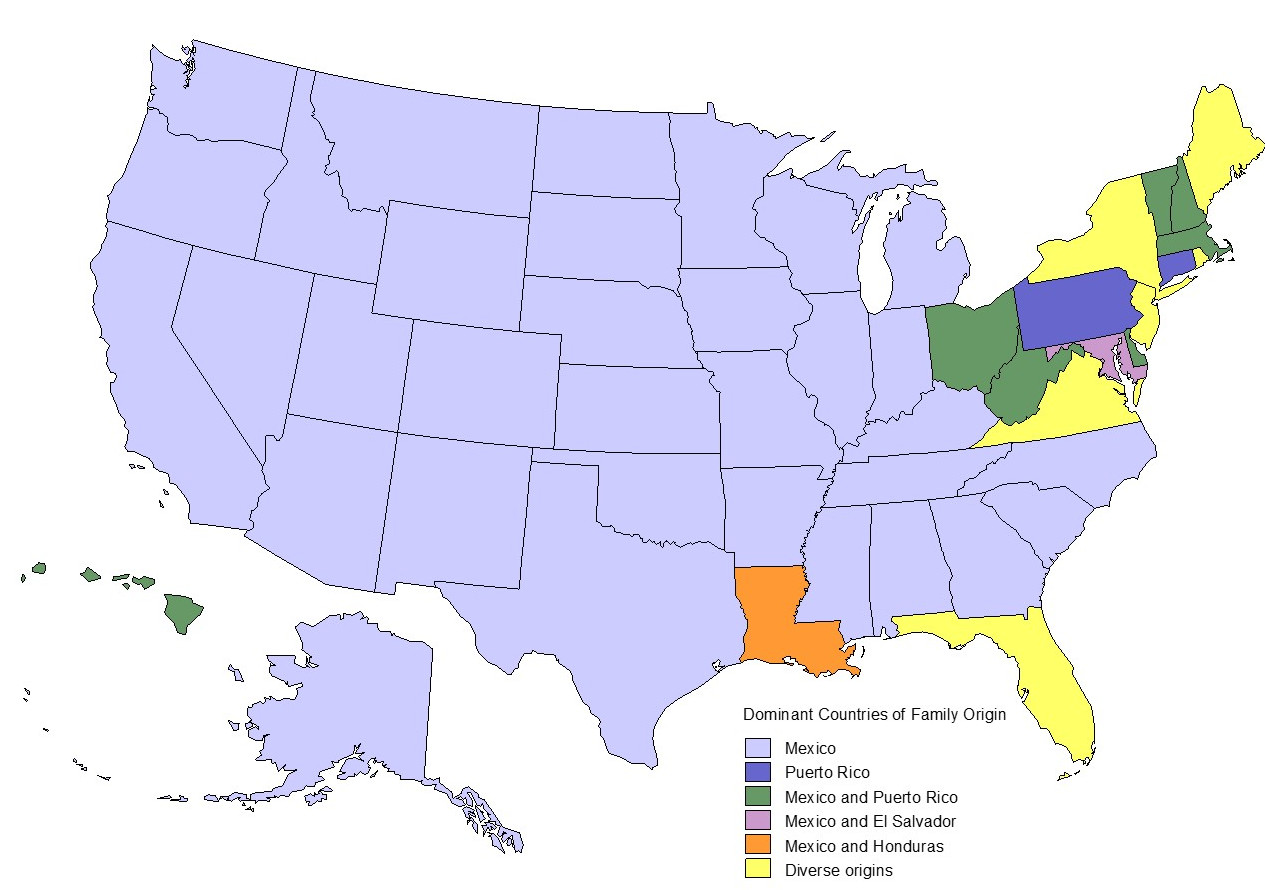Marissa Slowey
Former Research Assistant

July 19, 2017
Former Research Assistant
Latino children, who make up one-fourth of the population under age 18 in the United States, have made progress over the past 10 to 15 years in several key areas of well-being according to a report co-authored by PRB and UnidosUS (formerly the National Council of La Raza.) However, these children come from a wide range of ethnic backgrounds and countries of origin, and there are pronounced differences in the well-being of Latino children with different ethnic or national origins.
A majority of Latino children in the United States (68 percent) live in families with Mexican origins, but a growing number of Latino children have Central American and Caribbean backgrounds. Between 2010 and 2015, the percent of Latino children with Central American origins increased from 14.0 percent to 14.5 percent, while the share of Latino children in families with Caribbean backgrounds increased from 7.2 percent to 8.5 percent.
The most diverse Latino child populations are located in the Northeast—in Maine, New Jersey, New York, and Rhode Island—and in Florida and Virginia (see map). In Florida, large numbers of Latino children trace their origins to Mexico, Cuba, and Puerto Rico. The majority of Latino children in Pennsylvania (54 percent) and Connecticut (52 percent) have origins in Puerto Rico. Maryland stands out because of its relatively large Salvadoran population (33 percent of Latino children), while a large share of Latino children in Louisiana are Honduran American (17 percent).

Note: A “dominant” country of origin is specified if at least 50 percent of Latino youth in a given state identify with that nationality (or combination of two nationalities).
Source: PRB analysis of data from the U.S. Census Bureau, 2015 American Community Survey PUMS
PRB analyzed differences in the well-being of Latino youth across four measures: children living in poverty, children living in single-parent families, young adults ages 16-19 who are high school dropouts, and children without health insurance (see table). Latino children with different countries of origin experience pronounced variations in well-being. For example, Latino children from South America have lower poverty levels than Latino children as a whole (16 percent vs. 30 percent), are less likely to live in single-parent families (33 percent vs. 42 percent), and less likely to drop out of high school (2 percent vs. 6 percent).
|
Live in Poverty (%)
|
Live in single-parent family (%)
|
High School dropouts (%)
|
Uninsured (%)
|
|
|
All U.S. Children
|
21
|
35
|
4
|
5
|
|
U.S. Latino children
|
30
|
42
|
6
|
8
|
|
Mexican
|
32
|
40
|
6
|
8
|
|
Caribbean
|
31
|
53
|
5
|
4
|
|
Central American
|
31
|
43
|
8
|
11
|
|
South American
|
16
|
33
|
2
|
6
|
|
Other Hispanic
|
24
|
40
|
5
|
6
|
Note: Data are for the population under age 18 with the exception of high school dropouts (ages 16-19).
Source: PRB analysis of data from the U.S. Census Bureau, 2015 American Community Survey PUMS
However, other groups of Latino children do not fare as well on these indicators. Fifty-three percent of Caribbean children (children with origins from Puerto Rico, Cuba, and the Dominican Republic) live in single-parent families, compared to 42 percent of all Latino children. Latino children from Central America have the highest high school dropout rates (8 percent) and are more likely to be uninsured (11 percent).
Many of these disparities reflect not only initial circumstances of families’ migration to the United States, but also differences in generational status. For example, families tend to become less stable among Latinos the longer they live in the United States, as shown among Puerto Rican and Dominican children—many of whom live in second- or third-generation families. In contrast, educational attainment and economic mobility tend to improve across generations, particularly between first- and second-generation immigrants.1 Latino youth with origins from Central America—who are more likely to have immigrated to the United States in recent years—have the highest high school dropout rate among Latino groups.
The diversity in the U.S. Latino population is often overlooked in broad policy discussions about Latino families and children. But to promote and enact equitable policies, policymakers in different states and local areas need to tailor their strategies to the unique characteristics and specific needs of Latino families and children in their jurisdictions.
1. Pew Research Center, “Second-Generation Americans: A Portrait of the Adult Children of Immigrants,” accessed at www.pewsocialtrends.org/2013/02/07/second-generation-americans/, on April 6, 2017.
